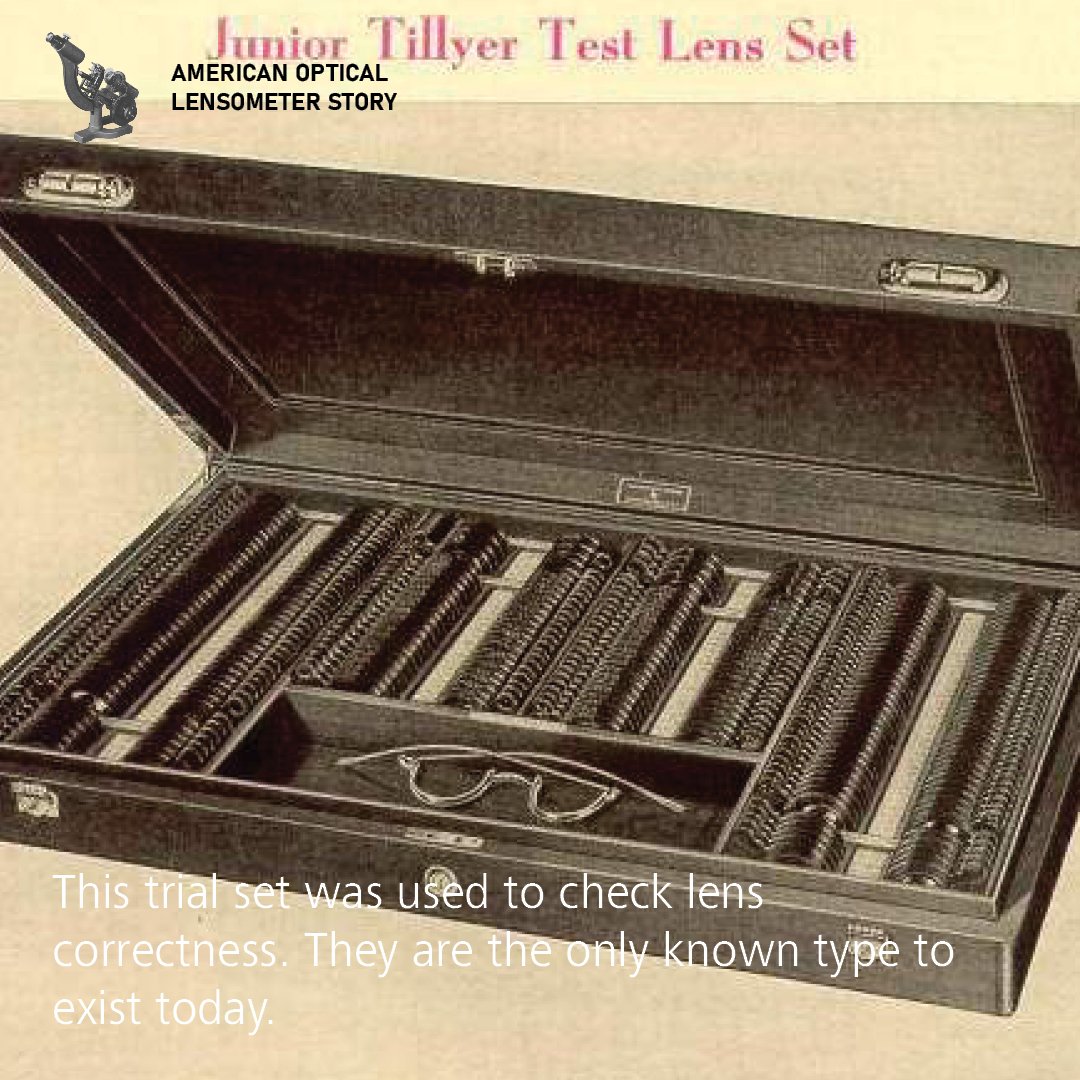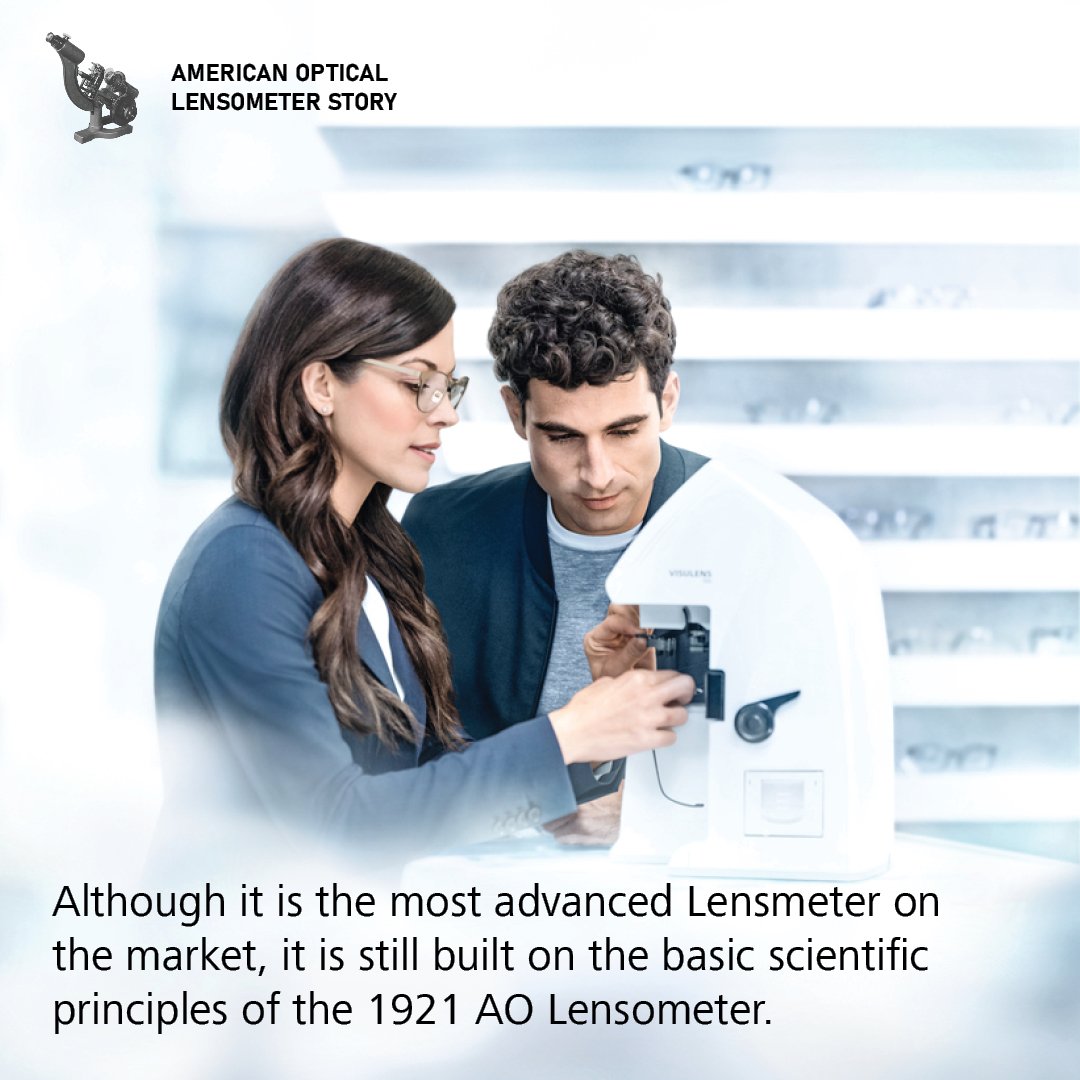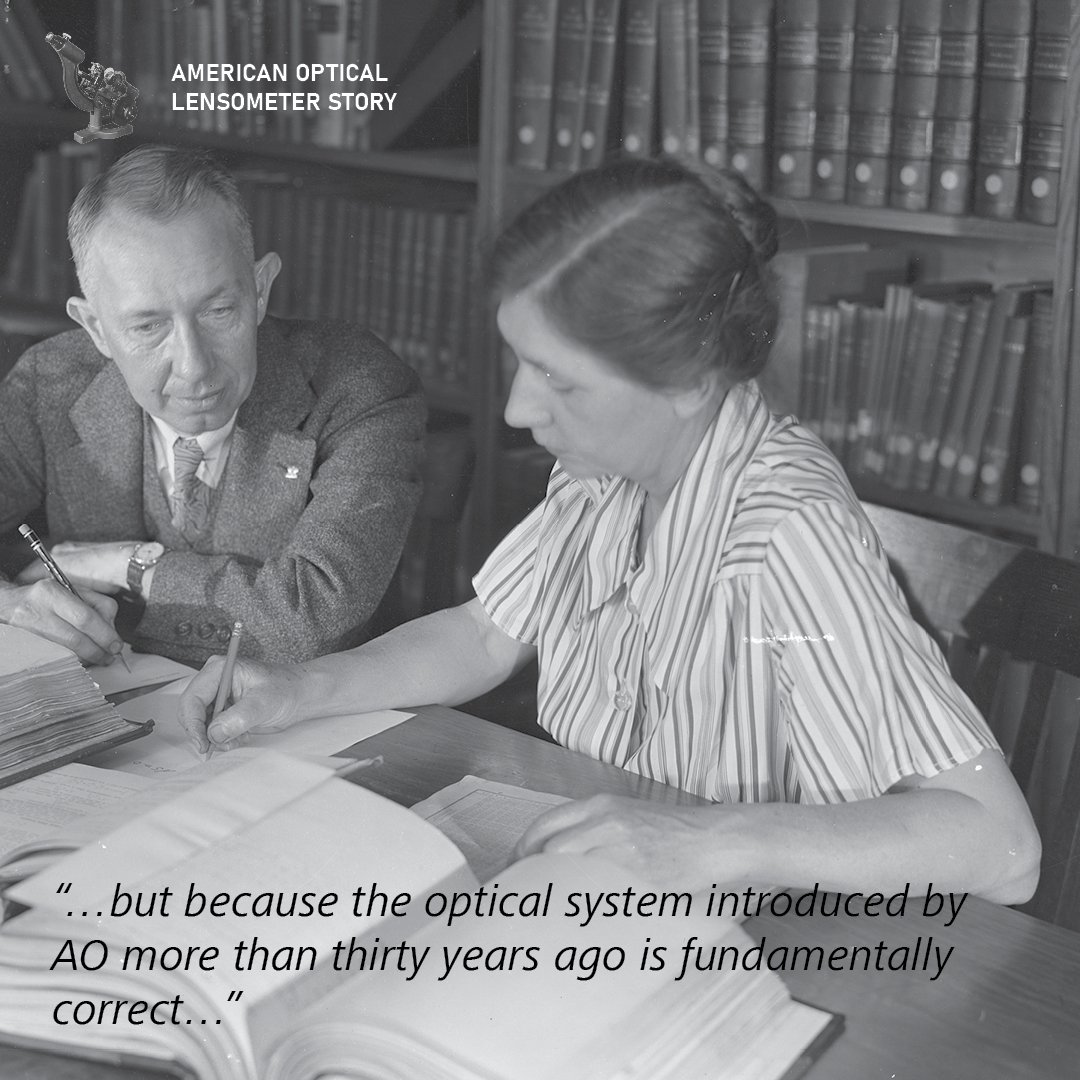
REVOLUTIONIZING the optical industry
THE AMERICAN OPTICAL LENSOMETER
It is difficult today to appreciate the impact of the Lensometer, 100 years since its introduction into optical offices.
The following story documents the Lensometer journey from conception into the game changing device it is today!
AO 12620
1970
ZEISS Visulens
2019
Jr. Lensometer
1938
AO Lensometer
1921
A problem to be solved
Prior to the Lensometer, there was no practical method to check if custom lenses produced to an individual prescription were of the proper power. Dispensing the correct power lens was done by trial & error.
Artwork at the turn of the century even depicted this process in action.
At times, glasses were dispensed by age category
Patients tried various power lenses, much like what is done for reading glasses at the pharmacy today.
Dr. Tillyer
In 1916, AO hired Edgar “Doc” Tillyer as AO Director of Research.
Tillyer was a true man of science, with a vast breadth of knowledge and contagious enthusiasm for optics, respected worldwide by experts in the field.
Prior to his employment. at AO, Dr. Tillyer worked with the National Bureau of Standards
Despite his involvement with the Lensometer, his greatest achievement was perhaps the Tillyer lens, the most advanced lens design at the time
Dr. Glancy
Shortly afterwards, Tillyer hired Dr Estelle Glancy as his right hand person for matters relating to lens design. Dr Glancy was a brilliant & distinguished mathematician & scientist in her own right.
Together, Tillyer & Glancy made a formidable team.
Dr Estelle Glancy was responsible for many of the complex mathematical calculations involved in ophthalmic optics at the time
Millions of consumers would go on to benefit from the improved optics that Dr. Glancy’s game-changing work introduced
Tillyer & Glancy worked to understand the theoretical foundations of an early AO focimeter (the precursor to the Lensometer)
Ongoing Development
Once Tillyer & Glancy had a design and working prototypes, they were challenged to transform the large and bulky focimeter into an easy to operate, compact & economical device.
But before this could happen, the focimeter needed calibration for accuracy.
The earliest focimeter prototypes were large and quite limited by comparison
Once the scientific principals had been established, the task was to make the device more compact with improved features
Standardized Lenses
Prior to his employment at AO, Tillyer produced a complete set of accurate, standardized lenses for the National Bureau of Standards.
This set was used to calibrate the Lensometer & today, is displayed at the Optical Heritage Museum - the only known set in existence
This trial set was used to check lens correctness. They are the only known type to exist today.
Their accuracy and acceptance as the “industry standard” made them the ideal calibration set from which to base the scientific calculations of the Lensometer
Delayed Release
In 1916, American Optical were preparing to commercialize their Lensometer, marketed as the “Wellsworth Lensometer”.
However, the release was paused due to the beginnings of WW1. The Wellsworth Lensometer was eventually introduced in 1921 - 5 years later.
Early forms of advertising could be seen, introducing the lensometer, despite the release being delayed
This delay allowed for ongoing refinements. The lensometer underwent several updates before a single design was settled on.
Junior Lensometer
American Optical continued to improve and refine its 1921 Wellsworth Lensometer.
By 1938, AO launched the “Junior Lensometer” with innovations including a table fixture and an ink dotting device. This was the most successful selling Lensometer in history!
Estelle Glancy had a major influence on the development of the Junior Lensometer – she even wrote the operators manual
This device was so successful, it remained largely unchanged for 30 years, after its introduction in 1938
American Optical Catalogs from the 1940’s show the list price to be $310, rising to $435 by 1958 - a far cry from the prices seen today.
12603
AO continued to refine the Lensometer, offering more features which allowed opticians to offer highly accurate prescription lenses. The "12603" was the latest upgrade with big shoes to fill. The biggest change was the styling, with colors to match the 70’s
The 12603 needed to capture attention. The previous generation “Junior Lensometer” sold for 30 years without any major upgrades
Designed to suit the optical offices at the time, the “12603” came in a variety of color options
The Lensometer Goes Digital
Greater accuracy & reduced errors were at the forefront of Lensometer development through the 70’s & this was achieved by the “12620” – the first digital Lensometer.
Complicated designs could suddenly be dispensed easily, thanks to the digital readout & automated calculations.
As stated in the sales brochure, “note taking and hand calculations are a thing of the past”. This proved to be correct
With the added digital readout and automated calculations, this was the first step towards modern lensmeters we see today
ZEISS VISULENS 550
The Lensometer continued to improve, as did the technology around it. Modern lensometers today offer far superior features than their predecessors.
The ZEISS VISULENS 550 is the most advanced Lensometer on the market, creating a new level of patient care & satisfaction.
Some new features include UV transmittance readers and Shack-Hartmann sensor to accurately measure a lens set without any adjustment to the Abbe number.
Although it is the most advanced Lensmeter on the market, it is still built on the basic scientific principles of the 1921 AO Lensometer.
Advanced Accuracy
In 2008, the Vision Council Lens Technical Committee studied the accuracy of today's Lens measuring devices.
They found that modern commercial devices are no more accurate than the Wellsworth Lensometer, developed over 100 years ago.
The fundamental scientific principals of the 1921 AO Lensometer took 10 years to calculate
Despite technology improvements, the accuracy of each device remains largely unchanged
A True Legacy
With over half of the developed world wearing prescription glasses, billions of people benefit from the legacy created by the Lensometer.
The 1921 AO Lensometer is on display & commemorated at the Optical Heritage Museum.
The AO Lensometer of 1921 ushered in a new era of accurately dispensing complicated lens designs
With the number of people the AO Lensometer has influenced, it is arguably the most revolutionary device in optical history
The AO Lensometer was awarded “Landmark status” by the American Society of Mechanical Engineers in March 2023
An Indispensable Instrument
“Like books, instruments come and go, and their permanence depends on their continued need. As long as spectacles are worn, the Lensometer will be indispensable”. -E. Glancy (circa 1950).
“It has gone through manufacturing changes, functional changes…in the interest of easy operation, and modification in styling for beauty of appearance…”
“…but because the optical system introduced by AO more than thirty years ago is fundamentally correct…”
“…optical principles remain unchanged and provide inherently for a surprisingly large number of operations.” -E. Glancy (circa 1950).
You might also like…
Landmark Ceremony
An event recap, honoring the AO Lensometer as a Landmark piece of Engineering equipment
Estelle Glancy
the First Lady of Optics



































